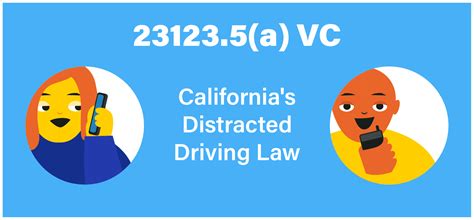California Mobile Phone Driving Law

The California mobile phone driving law is a set of regulations aimed at reducing the risk of accidents caused by distracted driving. As of 2017, California Vehicle Code Section 23123.5 prohibits drivers from holding and operating a handheld wireless telephone or electronic communication device while driving. This law applies to all drivers in California, including those with out-of-state licenses. The primary goal of this legislation is to minimize the distractions associated with mobile phone use while driving, thereby enhancing road safety.
Under the California mobile phone driving law, drivers are allowed to use their phones in a hands-free mode, such as through Bluetooth or a mounted device. However, they are not permitted to hold their phones or engage in any activity that requires them to hold the device, such as texting, browsing, or taking photos. The law also prohibits drivers from using their phones to send, read, or write text messages, emails, or instant messages while driving. Drivers who violate this law may be subject to a fine of $162 for the first offense and $285 for subsequent offenses.
Key Points
- The California mobile phone driving law prohibits drivers from holding and operating a handheld wireless telephone or electronic communication device while driving.
- Drivers are allowed to use their phones in a hands-free mode, such as through Bluetooth or a mounted device.
- The law prohibits drivers from using their phones to send, read, or write text messages, emails, or instant messages while driving.
- Violations of the law may result in fines of $162 for the first offense and $285 for subsequent offenses.
- Emergency services, such as calling 911, are exempt from the law.
Hands-Free Mode and Exceptions

The California mobile phone driving law allows drivers to use their phones in a hands-free mode, such as through Bluetooth or a mounted device. This means that drivers can make and receive calls, as well as use voice commands to send and receive messages, as long as they do not hold their phones. However, there are some exceptions to this rule. For example, drivers who are 18 years or older are allowed to use their phones to make emergency calls, such as calling 911. Additionally, drivers who are licensed commercial drivers are subject to federal regulations that prohibit them from using handheld phones while driving.
Consequences of Distracted Driving
Distracted driving is a significant contributor to accidents on California roads. According to the California Department of Motor Vehicles (DMV), distracted driving was a factor in over 80,000 crashes in 2020, resulting in over 400 fatalities. The most common distractions include using a mobile phone, eating or drinking, and conversing with passengers. The California mobile phone driving law aims to reduce the number of accidents caused by distracted driving by minimizing the distractions associated with mobile phone use.
| Year | Number of Crashes | Number of Fatalities |
|---|---|---|
| 2018 | 73,357 | 355 |
| 2019 | 76,421 | 382 |
| 2020 | 80,145 | 404 |

Implications and Future Developments

The California mobile phone driving law has significant implications for drivers, policymakers, and law enforcement. The law requires drivers to be more mindful of their mobile phone use while driving and to take steps to minimize distractions. Policymakers must continue to evaluate the effectiveness of the law and make adjustments as needed. Law enforcement agencies must also be proactive in enforcing the law and educating drivers about the risks of distracted driving. As technology continues to evolve, it is likely that the law will need to be updated to address new forms of distracted driving, such as the use of augmented reality devices or other emerging technologies.
Comparison with Other States
California is not alone in its efforts to reduce distracted driving. Many other states have implemented similar laws and regulations to prohibit the use of handheld devices while driving. For example, states like New York, New Jersey, and Oregon have laws that prohibit drivers from holding and operating handheld devices while driving. However, there are some differences in the laws and regulations between states. For instance, some states allow drivers to use their phones in certain situations, such as when stopped at a red light or in a parking lot. It is essential for drivers to be aware of the laws and regulations in their state and to take steps to minimize distractions while driving.
What is the penalty for violating the California mobile phone driving law?
+The penalty for violating the California mobile phone driving law is a fine of $162 for the first offense and $285 for subsequent offenses.
Are there any exceptions to the California mobile phone driving law?
+Yes, there are some exceptions to the law. For example, drivers who are 18 years or older are allowed to use their phones to make emergency calls, such as calling 911. Additionally, drivers who are licensed commercial drivers are subject to federal regulations that prohibit them from using handheld phones while driving.
How can I minimize distractions while driving?
+To minimize distractions while driving, you can take several steps. First, put your phone on silent mode and keep it out of reach while driving. Second, avoid eating or drinking while driving. Third, refrain from conversing with passengers or engaging in other activities that may distract you from the road. Finally, consider using a hands-free device or a phone app that helps you stay focused on the road.
Meta description suggestion: “Learn about the California mobile phone driving law, including the penalties for violating the law, exceptions, and tips for minimizing distractions while driving.”


